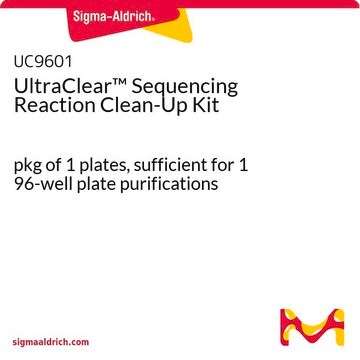S5059
SigmaSpin™ Sequencing Reaction Clean-Up
post-reaction clean-up columns
Synonyme(s) :
sequencing clean up columns
Se connecterpour consulter vos tarifs contractuels et ceux de votre entreprise/organisme
About This Item
Code UNSPSC :
41106300
Nomenclature NACRES :
NA.52
Produits recommandés
Température de stockage
2-8°C
Vous recherchez des produits similaires ? Visite Guide de comparaison des produits
Application
SigmaSpin® Sequencing Reaction Clean-Up has been used in the synthesis of antisense RNA probe.
Ideal for removing dye-terminator nucleotides and primers from sequencing reactions and radiolabeled nucleotides, primers, and fluorescent dyes from nucleic acid probe labeling reactions.
Autres remarques
SigmaSpin Post-Reaction Clean-Up Columns are ideal for lower throughput applications, such as clean-up of probe labeling reactions or small numbers of sequencing reactions. These columns can accept sample volumes up to 100 μL. Each column comes with a collection tube to collect the DNA during centrifugation.
SigmaSpin Post-Reaction Clean-Up columns provide a fast, simple, and highly efficient method for removing unincorporated dyes, excess salts, and other interfering reaction components. Each column is packed with a pre-hydrated size-exclusion resin, equilibrated with molecular biology grade water, and supplied in our unique column design. The column also includes a snap-cap bottom seal and an o-ring containing screw-cap to ensure that the resin remains hydrated. SigmaSpin has been tested in high-throughput genome centers and core facilities with ABI PRISM® 3700, 3100, 310 and 377. Each well can accept sample volumes up to 20 μL.
SigmaSpin Post-Reaction Clean-Up columns provide a fast, simple, and highly efficient method for removing unincorporated dyes, excess salts, and other interfering reaction components. Each column is packed with a pre-hydrated size-exclusion resin, equilibrated with molecular biology grade water, and supplied in our unique column design. The column also includes a snap-cap bottom seal and an o-ring containing screw-cap to ensure that the resin remains hydrated. SigmaSpin has been tested in high-throughput genome centers and core facilities with ABI PRISM® 3700, 3100, 310 and 377. Each well can accept sample volumes up to 20 μL.
For additional information, please see www.sigma-aldrich.com/sequencing.
Informations légales
ABI PRISM is a registered trademark of Applera Corporation or its subsidiaries in the US and/or certain other countries
SabreLite is a registered trademark of Pelican Products, Inc.
SigmaSpin is a trademark of Sigma-Aldrich Co. LLC
Code de la classe de stockage
11 - Combustible Solids
Classe de danger pour l'eau (WGK)
WGK 3
Point d'éclair (°F)
Not applicable
Point d'éclair (°C)
Not applicable
Certificats d'analyse (COA)
Recherchez un Certificats d'analyse (COA) en saisissant le numéro de lot du produit. Les numéros de lot figurent sur l'étiquette du produit après les mots "Lot" ou "Batch".
Déjà en possession de ce produit ?
Retrouvez la documentation relative aux produits que vous avez récemment achetés dans la Bibliothèque de documents.
Seong Hyeok Cho et al.
Biochemical and biophysical research communications, 498(3), 431-436 (2018-03-03)
The goal of this study is to determine the anti-cancer mechanism of Cordycepin in A549 Cisplatin-Resistance (CR) lung cancer cells. Cordycepin inhibited the viability of A549CR cells in a dose-dependent manner. The cell inhibition was due to induction of apoptosis
Martin R Silic et al.
Genetics, 215(4), 1067-1084 (2020-06-18)
The roles of bioelectric signaling in developmental patterning remain largely unknown, although recent work has implicated bioelectric signals in cellular processes such as proliferation and migration. Here, we report a mutation in the inwardly rectifying potassium channel (kir) gene, kcnj13/kir7.1
Kateřina Švehlová et al.
Nucleic acids research, 44(22), 10789-10803 (2016-10-30)
A fundamental motif in canonical nucleic acid structure is the base pair. Mutations that disrupt base pairs are typically destabilizing, but stability can often be restored by a second mutation that replaces the original base pair with an isosteric variant.
High-resolution in situ hybridization to whole-mount zebrafish embryos.
Thisse C and Thisse B
Nature Protocols, 3(1), 59-69 (2008)
Ray Chang et al.
Acta biomaterialia, 111, 221-231 (2020-05-23)
Gene transfection is important in biotechnology and is used to modify cells intrinsically. It can be conducted in cell suspension or after cell adhesion, where the efficiency is dependent on many factors such as the type of nanocarrier used and
Notre équipe de scientifiques dispose d'une expérience dans tous les secteurs de la recherche, notamment en sciences de la vie, science des matériaux, synthèse chimique, chromatographie, analyse et dans de nombreux autres domaines..
Contacter notre Service technique







